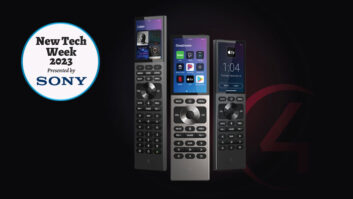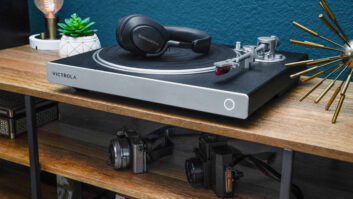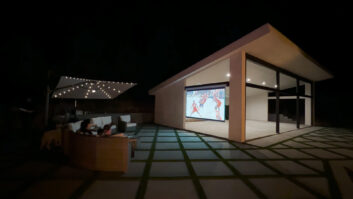Sharpness is generally considered a four-letter word among videophiles. In fact, most calibrators typically reduce a display’s sharpness control to zero, because we’ve been taught that “sharpness” is not something you can add to an image, and it just creates problematic artifacts at the expense of actual detail.

Darbee doesn’t claim to add sharpness with its DVP5000 video processor. Rather it is “visual presence” created “by embedding 2D and 3D pictures with depth information.”Thus, I connected DarbeeVision’s DVP5000 (you’ll excuse me if I won’t call it “the Darblet”) with a degree of skepticism. To be fair, Darbee doesn’t claim to add sharpness, rather it is “visual presence” created “by embedding 2D and 3D pictures with depth information.” Call it whatever you want, I’m gonna spoil this review now by saying I call the DVP5000 frickin’ amazing!
In fact, cycling the Darbee’s processing on/off revealed more significant detail differences than I’ve noticed on 4K demonstrations I’ve seen. With 4K, I am often searching for subtle details; looking for specific resolution improvements, or staring at side-by-side still image comparisons. But with the Darbee, I could see an instantly improved picture even with moving images.
Out of the box, the DVP5000 is a rather unimpressive component; basically a blue, plastic shell/case about the size of two stacked iPhone5s containing a circuit board. An HDMI input goes from your source on one side, the video runs through the circuitry and is slathered in Darbee special sauce, and an HDMI output on the other side carries video to your display. The unit is so light that my heavy HDMI cables kept trying to pull it off the shelf. I connected the DVP5000 inline between my Marantz AV8801’s dual HDMI outputs and my video displays; one connected to my 9G Elite Plasma and another to my Marantz video projector.
The DVP5000 has four control buttons, but using the credit card-sized remote is easier. (There is an IR input to control it via a third-party control system). After dimming (or defeating) the front panel indicator lights, the buttons you’ll typically use are On/Off, More and Less Darbee, and Demo.
Typically, reviewing a component requires living with the gear for a bit and slowly discovering its benefits or drawbacks. Not so with the DVP5000, as the first time I toggled the on/off button there was a “Holy sh–!” moment as my display produced images I’d never experienced before. And, remember, I used it on a 9G Elite plasma, still generally regarded as the best TV ever made, so I’m used to incredible images.
The DVP5000 has three different processing modes called hi def, gaming, and full pop. Stick with hi def as the other two added processing to the point of degrading the picture. (However I didn’t actually play any games.) The full pop mode created horrible smearing in the titles and cover art on my Kaleidescape and similar “damage” to actual video. If you’re starting with un-scaled, 480i/p content then perhaps full pop would be an option, but I had best results with hi def. You can add more or less Darbee–ranging between 0-120– and I set it at 80-85. Also, having your display already calibrated or with any video processing or “enhancements” turned off (“pure” in Elite parlance) works best.
Over and over again, I was shocked by how soft and defocused the image looked when I’d turn Darbee’s processing off. It was as if I had smeared a thin layer of Vaseline on the camera lens, and the Darbee came by and polished it to a hyper-focused clean. The processing shines best with extracting micro detail, like fine checkered or herringbone patterns, individual strands of hair, whiskers, and leaves on trees. Darbee retrieves those details that are normally lost, producing a far more revealing image.
Here are a few examples where the DVP5000 noticeably improved the picture. The star field in the opening of Star Wars: Episode IV was a much inkier black, with individual stars becoming defined and distinct. The snow banks in the Empire Hoth battle became rolling, individual hills with far more dimensional shadow depth and detail. The haystacks in the Ba’ku village scene of Star Trek Insurrection went from piles of mush to individual bits of hay. Patterns and design detail in Penny’s clothing on The Big Bang Theory stood out in clear, pinstripe detail.
When watching old or noisy video, Firefox for instance, the Darbee “enhanced” undesirable noise and grain in the image, bringing far more attention to it; a case where using less Darbee is better. Also, it added significant artifacts to the luma and chroma zone plate patterns on the Spears & Munsil High-Definition Benchmark Blu-ray; however that is unlikely to be noticed in real-world viewing.
Video has become a non-profit commodity item, but the Darbee DVP5000 gives installers a way to quickly and easily demonstrate an affordable way to make any TV look its best. Demo it in your showroom–or in a customer’s living room– and they probably won’t want to live without it. I know I don’t.
657.600.8241
www.darbeevision.com
Kudos
No matter how good your display is, the DVP5000 will make better looking images; incredibly easy to demonstrate image enhancement
Concerns
Not very impressive looking hardware; cable weight can pull it off shelf; having to call it “the Darblett”
Product Specs
• Compatible with HDMI 1.4 or less, including 1080p60 and 3D
• Three processing modes: Hi Def, Gaming, and Full Pop
• Connections: HDMI input, HDMI output, 5V DC input, IR mini-jack input
• Dimmable/defeatable front panel indicators
• Demo mode produces a split screen (unprocessed/ processed) or continuous wipe.
• Dimensions: 3.1 x 2.5 x .6 (L x W x H, inches), 4.2 ounces







